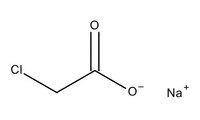820293 Sigma-AldrichChlorooctan sodowy
Sodium chloroacetate for synthesis. CAS No. 3926-62-3, EC Number 223-498-3.
More>> Sodium chloroacetate for synthesis. CAS No. 3926-62-3, EC Number 223-498-3. Less<<Synonyms: Chloroacetic acid sodium salt
Recommended Products
Przegląd
| Replacement Information |
|---|
Tabela kluczowych gatunków
| CAS # | EC Number | Hill Formula | Chemical Formula | Molar Mass |
|---|---|---|---|---|
| 3926-62-3 | 223-498-3 | C₂H₂ClNaO₂ | ClCH₂COONa | 116.48 g/mol |
Products
| Numer katalogowy | Opakowanie | Ilość/opak. | |
|---|---|---|---|
| 8202930100 | Butelka plastikowa | 100 g | |
| 8202930500 | Butelka plastikowa | 500 g |
| Description | |
|---|---|
| Catalogue Number | 820293 |
| Synonyms | Chloroacetic acid sodium salt |
| References |
|---|
| Product Information | |
|---|---|
| CAS number | 3926-62-3 |
| EC index number | 607-158-00-5 |
| EC number | 223-498-3 |
| Hill Formula | C₂H₂ClNaO₂ |
| Chemical formula | ClCH₂COONa |
| Molar Mass | 116.48 g/mol |
| HS Code | 2915 40 00 |
| Structure formula Image | |
| Quality Level | MQ200 |
| Applications | |
|---|---|
| Application | Sodium chloroacetate for synthesis. CAS No. 3926-62-3, EC Number 223-498-3. |
| Biological Information |
|---|
| Physicochemical Information | |
|---|---|
| Flash point | 270 °C |
| Melting Point | 199 °C (rozkład) |
| pH value | 4.5 - 9.0 (50 g/l, H₂O, 20 °C) |
| Vapor pressure | <0.1 hPa (20 °C) |
| Bulk density | 850 kg/m3 |
| Solubility | 820 g/l |
| Dimensions |
|---|
| Materials Information |
|---|
| Toxicological Information | |
|---|---|
| LD 50 oral | LD50 Szczur 95 mg/kg |
| LD 50 dermal | LD50 Szczur > 2000 mg/kg |
| Safety Information | |
|---|---|
| Categories of danger | substancja toksyczna, substancja dra?ni?ca, substancja niebezpieczna dla ?rodowiska |
| Product Usage Statements |
|---|
| Storage and Shipping Information | |
|---|---|
| Storage | Przechowywać poniżej +30°C. |
| Packaging Information |
|---|
| Transport Information | |
|---|---|
| Declaration (railroad and road) ADR, RID | UN 2659 , 6.1, III |
| Declaration (transport by air) IATA-DGR | UN 2659 , 6.1, III |
| Declaration (transport by sea) IMDG-Code | UN 2659 , 6.1, III |
| Supplemental Information |
|---|
| Specifications | |
|---|---|
| Assay (HClO₄) | ≥ 98.0 % |
| Identity (IR) | passes test |
| Global Trade Item Number | |
|---|---|
| Numer katalogowy | GTIN |
| 8202930100 | 04022536456058 |
| 8202930500 | 04022536456065 |
Documentation
Chlorooctan sodowy MSDS
| Title |
|---|
Chlorooctan sodowy Certificates of Analysis
| Numer katalogowy | Opakowanie | Specyfikacja | Numer partii |
|---|---|---|---|
| 8202930100 | Butelka plastikowa | Dokument ze specyfikacją, w formacie PDF | |
| 8202930500 | Butelka plastikowa | Dokument ze specyfikacją, w formacie PDF |







